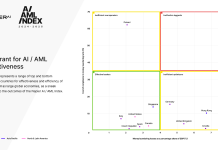Founded in 2021, the mission of Berlin-headquartered Flagright is to protect FinTechs from financial crime with real-time and risk-based transaction monitoring, case management, sanctions screening and ID verification products.
In his previous role, Flagright co-founder and CEO Baran Özkan worked at a FinTech as a director of product, where he was responsible for financial crime prevention.
During his time in the job, he spent 15 months testing transaction monitoring providers, only to find products that didn’t meet the company’s needs.
“We cared about identifying suspicious activity instantly to secure our instant transactions. Throughout the evaluation period, these providers lied to me about what they could do, some of them simply wasn’t capable, some of them had bad developer experience, some of them had bad UX, and some of them quoted astronomical amounts like we were a bank,” said Baran.
Due to this, Baran said he validated the problem that FinTechs were underserved with anti-financial crime tooling, with existing providers either outdated or only wanting to tailor to large banks. “This led to me quitting my job and chasing this problem to arm fintechs with the next generation anti-fincrime software, and eventually, Flagright,” the Flagright CEO stated.
Flagright serves a multitude of use cases including transaction monitoring, customer risk assessment and sanctions screening amongst others. The company consists of one powerful API and a centralised, no-code platform to help AML and fraud teams.
Baran explained, “Flagright infrastructure optimizes for speed and availability; it can compute advanced algorithms and run aggregations with sub-second response times. This means even the complex rules that are traditionally run once a day can be run in real-time and surface suspicious activity at greater speed.
“The system abstracts financial crime to suspicious activity detection instead of the traditional delineation of AML versus fraud. It aims to understand a given user, establish expected behaviour for that user, and detect whether any given movement of money is expected or not based on what we know about them, be that an individual or entity,” he continued.
According to Baran, this is achieved by employing a range of supervised and unsupervised technologies that the company develops in-house. The firm’s application code can be distributed to data centers worldwide, enabling them to deliver the same quality and performance across six continents.
Flagright’s USP
What sets Flagright apart from competitors? Baran explained that Flagright offers the fastest integration times and the best developer experience among similar solutions worldwide.
In addition, the company claims it built an API-first product with a focus on developer experience from the first day, as it found the integration time to be a major investment factor and decision-making criteon amongst FinTechs.
Baran said, “The way Flagright’s system abstracts the problem of financial crime helps us build an intuitive, flexible, no-code platform to quickly onboard users and let them manage their rules, risk factors, and system configuration on their own without writing any SQL code, creating a ticket, or emailing customer support like most of other solutions require.
From an infrastructure perspective, the built-in quality demonstrates itself in daily usage of the platform. At Flagright, there is no delineation of real-time versus post-monitoring – Flagright’s system is always fast, always real-time, even for complex rules that are traditionally known to be ‘post-monitoring’.”
With financial products getting faster and more developed, criminals, threat actors and fraudsters follow suit. Due to this, Baran believes, a more responsive and agile pattern detection system is required.
Flagright also claims to offer 99.99% API uptime standard SLA for all of its customers at no additional cost. “Most providers will quote 99.7% or less, which means they will be down for more than 26 hours in any given year.
“If you assume 2 hours downtime per day for business days, imagine having a critical system going down every day for 3 weeks straight. We make set our priorities to make sure no FinTech has to deal with this type of disruption.
“Finally, we can be very competitive as we found a good balance between system performance and reliability versus the cost it generates us to maintain. A lower cost base for us means we can pass these benefits to our customers in pricing.”
The pain points Flagright is looking to solve include empowering people ‘in the first line of defence’ of AML and fraud teams. Whether this is money laundering, fraud, or terrorism financing, FinTechs can often be the target of criminals and illicit actors.
“By making our solution reliable, performant, and affordable, our goal is to protect FinTechs from getting hit by fraud and losing their business, from becoming an instrument to money laundering or a gateway to finance terrorism. We do this by making it easy to adopt our software and use it, which translates into a powerful API and an intuitive, no-code platform,” quipped Baran.
Real-time and risk based
Flagright offers modular products that can be integrated seamlessly on the same platform. These are real-time transaction monitoring and a customer risk assessment engine. Both of them are regulatory requirements.
Baran underlined, “We combined the two to enable risk-based transaction monitoring. Imagine the traditional approach – a FinTech onboards their customers, manages their risk factors on a spreadsheet and defines the risk level. Then they use their traditional transaction monitoring system where they keep the rules with a single threshold that apply to all customers.”
The problem, the Flagright CEO notes, is that some customers are low risk and some are high risk. So he asks – why would extra friction be introduced to the good users and why would we let the high-risk user expose the business?
He continued, “That’s the problem we are solving with risk-based monitoring approach, and we automate each step from the very beginning. Our risk engine tracks user behaviour and dynamically captures risk factors on KYC or transaction data.
This gets translated into risk levels for each user, and same rule applies different thresholds for each user based on their risk level. This lets our customers grow their revenue drastically by delivering a superior user experience compared their competitors, while protecting the business from fraud and regulatory risk as higher risk customers are treated with tailored attention.”
From the company’s early days, Baran said the company realized that the solution space is moving towards all-in-one approach. While the firm wanted to remain competitive, it also didn’t want to sacrifice quality.
That led Flagright to build partnerships in certain use cases instead of building everything in-house.
He explained, “We know we are making a difference for transaction monitoring, risk assessment, and case management, so we kept these technologies proprietary.
“However, we also believe there are already great providers in sanctions screening, ID verification, and blockchain analytics spaces. So, we built partnerships with the best-in-class providers and now our customers can leverage these partnerships in a single API, on a centralized, no-code platform.
“Our customers have only one commercial contract with Flagright and have a single point of contract. Under the hood, they get the ease of mind that they are getting the best-in-class services in all the products they choose to use.”
Future plans
Since its founding in 2021, Flagright has already come a long way. According to Baran, during that time, the product has become much more mature and is becoming ‘superior’ each day.
He said, “We see an increasing demand from larger organizations and preparing for exponential growth. Given the market conditions, our expectation is that FinTechs will be more diligent in reviewing their existing vendors and will double down on the ROI they get.
“This is great for us because we deliver a premium product that can be integrated in 4 days at a competitive cost, which maximizes the ROI for our customers.”
Copyright © 2023 RegTech Analyst
Copyright © 2018 RegTech Analyst






